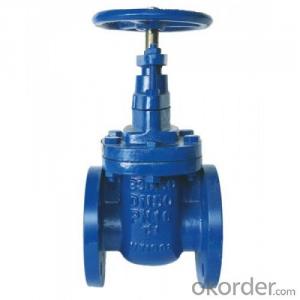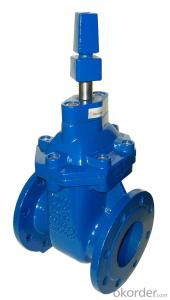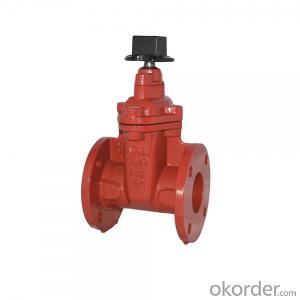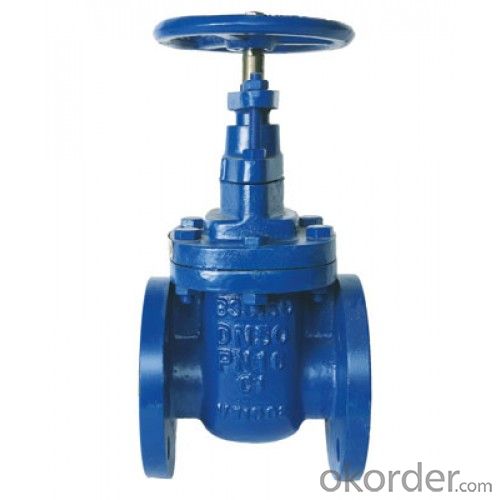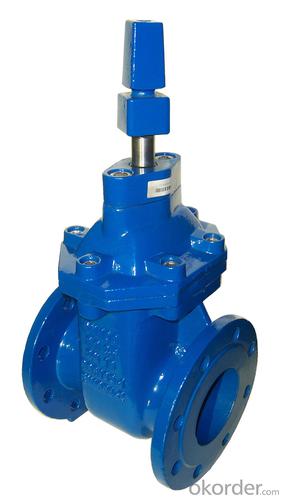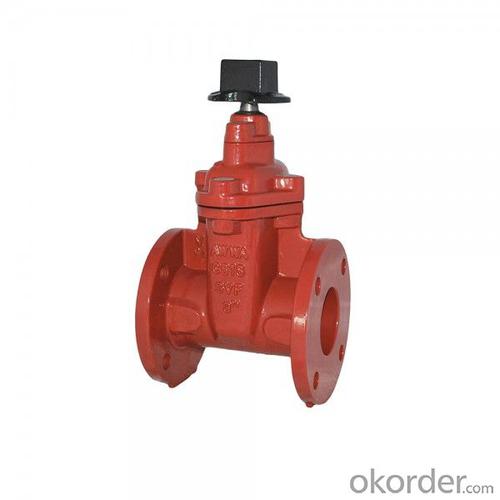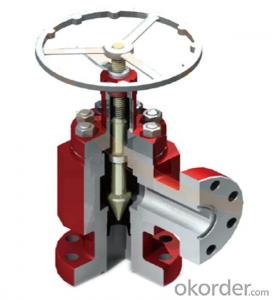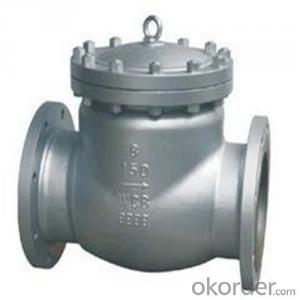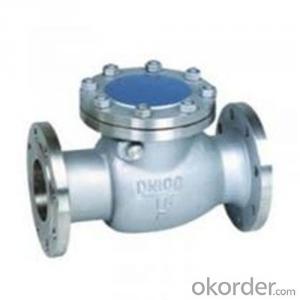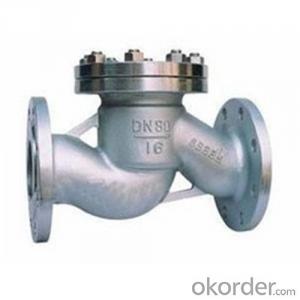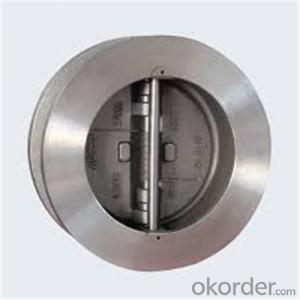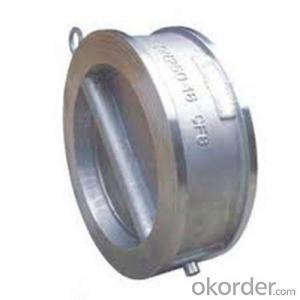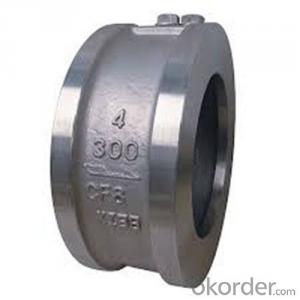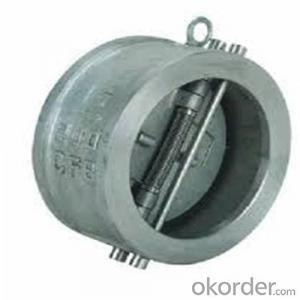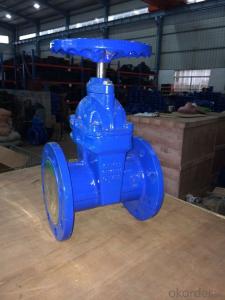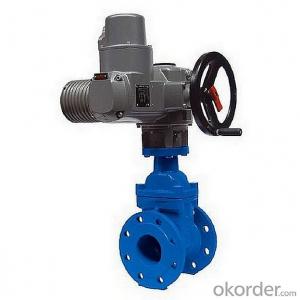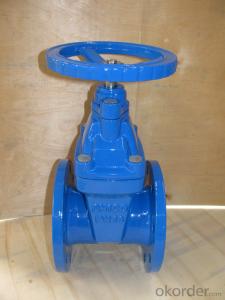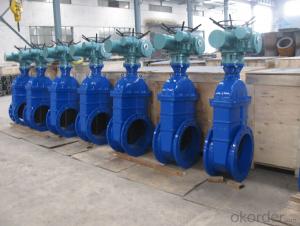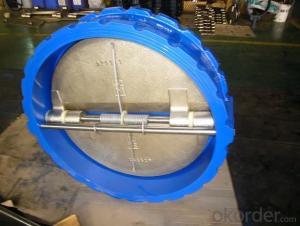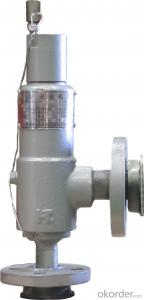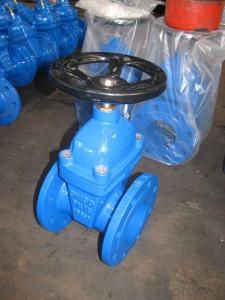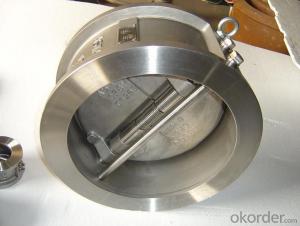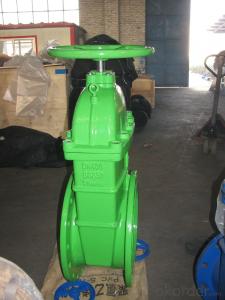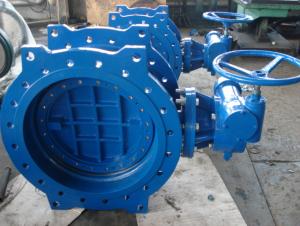Ductile Iron Gate Valve Non-Rising Stem of DIN3352 F4
- Loading Port:
- Tianjin
- Payment Terms:
- TT OR LC
- Min Order Qty:
- 10 unit
- Supply Capability:
- 100000 unit/month
OKorder Service Pledge
OKorder Financial Service
You Might Also Like
Non-rising resilient seated gate valves solve the problem in general gate valves such as leakage, rusting etc. and saves installation space. It is used widely in tap water industry, sewage treatment, shipping construction, petroleum, chemicals, food, pharmacy, textile, electric power, metallurgy and energy system's pipeline to adjust and shut off fluids.
l Replaceable O-ring
l Low torque operation
l Rubber encapsulated wedge
l Clockwise closing direction
l Fusion bonded epoxy coated inside and outside
Specification
Body materials: Ductile Iron
Design standard: DIN3352 F5
Design pressure: PN10/PN16/PN25
Size: DN80mm-DN2000
Connect type: Flanged gate valve
Seal type: Resilient seated gate valve, EPDM+ Ductile Iron
Coating:
Fusion bonded epoxy coated both on the interior as well as the exterior surfaces of the valve, flange surfaces are also fully epoxy coated, blue color.
Application
Potable water, neutral liquids, irrigation, heating and chilled water, fire systems etc, in either above ground or buried service applications and requires minimal maintenance
Feature
This Ductile Iron Resilient Seated Gate Valve is fully compliant to DIN3352 F4. We have light weight type, heavy weight type and even middle weight type for your reference, and these three options design construction of ductile iron will offer a robust and durable extended life performance.
1- Bolted bonnet, full bore: used for larger valves and higher pressure applications.
2- Stem sealed with O-rings: realize zero leakage, could be replace under full pressure.
3- Rubber encapsulated wedge: excellent elastic memory, ensure sealing effect.
4- Blue fusion boned epoxy coated inside and outside: suitable for portable water.
5- Working pressure from -1 to +16 and working temperature from -10 to +80°C
Durable
This valve is suitable for use in a wide range of applications including potable water, neutral liquids, irrigation, heating and chilled water, fire systems etc, in either above ground or buried service applications and requires minimal maintenance. This Resilient Seated Gate Valves have a rated working pressure of 16 Bar. The valves seal 100% leak tight. The waterway is clear, unobstructed and free from pockets. Resilient seated gate valves are fusion bonded epoxy coated both on the interior as well as the exterior surfaces of the valve, flange surfaces are also fully epoxy coated.
Advantage
1- OEM Factory : Professional manufacturer, clients from whole world.
2- High Quality, Competitive Price: Custom is accepted.
3- Complete Service: Long service Life, Fast delivery, Multilingual services.
4- Certificates: ISO9001, CE, NSF, TS, WRAS.
5- Low MOQ: Ready for providing the sample and producing some small orders.
FAQ
Q: Are you manufacturer of trading company? Which kind of valves do you supply?
A: We are a professional manufacturer of butterfly valves, check valve, non-return valves, gate valves, Y-strainer and so on.
Q: Will you do inspection before shipment? Whether Third Party Inspection is available?
A: We have a professional engineer team, so we can offer you the most professional technical support. All valves are tested twice before and after hammer pin to ensure its perfect sealing property and to make sure every valve is ok before ex-factory. TPI is ok but the clients should bear all fees.
Q: What kind of package do you use for these valves?
A: Valves from DN80-DN1400 will be packed in wooden boxes, but valves above DN1400 will be in wooden pallets. If you need wooden boxes for above DN1400, the price may be more expensive.
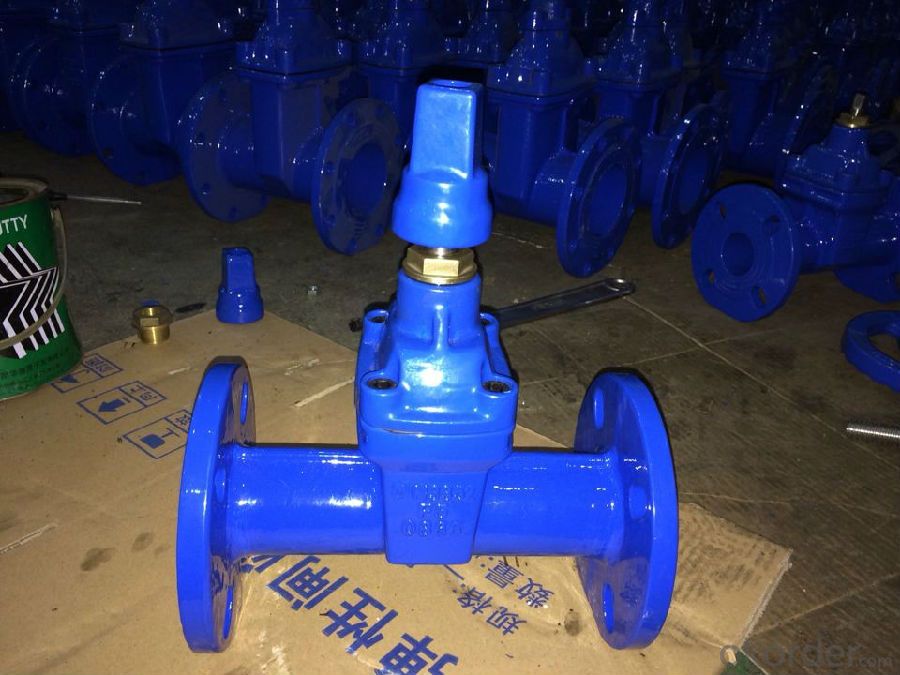
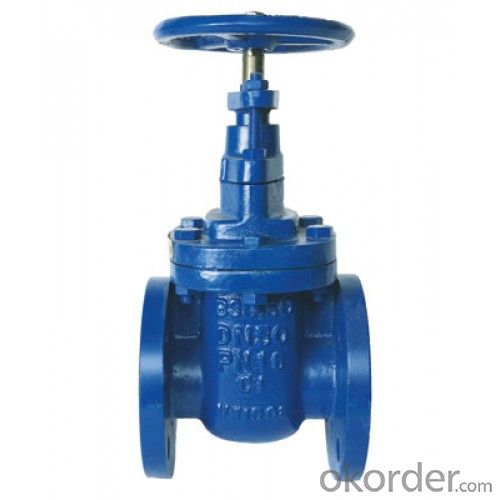
- Q: I was told Wed. that I need to have my aortic valve replaced. I was wondering if anyone could share their experience with this surgery good or bad. I am meeting with the surgeon on the 26th, and am very nervous. Any tips and or suggestions appreciated. I'm a 39 year old female.Thanks in advance
- if you have a tissue valve you will not need to be on coumadin the blood thinner but will need to have surgery repeated later on in life. if you have a mechanical valve placed then you will need to be on coumadin and typically it takes about a week to get your blood theraputic, then you will need to probably need to have you blood drawn weekly a few times immediately after. then it tapers down to once a month checks generally. goofd luck to you.
- Q: How do you clean an EGR valve on a 1999 Ford Taurus DOHC? What do I do and what can I use? Will water work? I've read a lot about a plunger mechanism but I have no idea what this is. Please explain in the best detail you can how to remove, clean, and re install the EGR valve?
- The egr valve doesnt get dirty on its own; if there is a problem with foreign material in it, its coming from the exhaust stream, not the valve. But if you need to clean it anyway, then just unbolt it, push in the valves plunger from the bottom, and pick out anything blocking the valve from closing. They do not plug up. Also, check to make sure the vapor holes where the valve bolts on are clean, they do plug up. the mechanics of it are pretty basic.
- Q: my dad's friend died, and dad had been keeping some valves of his. now we've been left with about 400 valves and i'm going to sell them.my main question is what are they used for? i need to write a description for ebay but have no idea what they're for! anyone know?also, how much should i sell them for? on the box it says 11 shillings, which i worked out as ?1.32, but how much should i sell them for on ebay? there's prices on ebay that are about 50p to ?1.50 for most of them, but some are about ?7 but have no bids at all. how much should i start the bidding at?also, if you could give me any other information that i should put in the description, i would really appretiate it :)they are mainly 'Mullard' valves (the company name) but some are 'MAZDA'thanks! :D
- Valves (we call them 'tubes' here in the US, but 'valves' is actually a better description of how they work) were used on all kinds of electronics up to the 1970s. Radios and TVs mostly but also musical instrument amplifiers, PA system, etc.etc. In fact some high-end 'audiophiles' believe valves give you a better sound, so even today there are special (very expensive) amplifiers for both stereos and for guitars, that still use them. Only certain ones though, the ones that do final-stage amplification. And they still make the valves for these. People will want them for restoring old electronic gear, and to keep on the shelf in case one of theirs dies (they have a limited life). I have no idea what they're worth, but the answer to that question is: Whatever someone is willing to pay for them. So you have a few choices. Find shops that restore old electronics and call them and ask if they have anyone who would asses your valves, or even better, if they're interested in just buying the whole lot of them as a lot. Or go on EBay and look for the particular numbers and see what they've been selling for.
- Q: A friend of mine who is 26, was just told by her doctor that she has aenlarged heart valve. Is this really serious? Will she need surgery? Why can't I find any info on the internet? Please help I'm really worried. Thanks
- there are two valves in the heart, a bicuspid valve (two flaps) and a tricuspid valve (three flaps). A valve serves to prevent the back flow of blood in the heart, keeps it all flowing in one direction. An enlarged or incompetent valve would obviously be unable to do it's work properly. How serious the issue is depends entirely on the extent of enlargement. Enlargement is usually a result of uncontrolled blood pressure issues, but can also be genetic. As she is seeing a doctor about this, suggest that you let the doctor worry about it.
- Q: I have a 79 ford F-150 and i was wondering where the pcv valve was my truck will start but it wont idle until its reached normal operating temp i was told that it might be my pcv valve is that correct or what else could it be. thanks
- You didn't say what type of engine but it's on the valve cover the a black hose attached to it, on a v-8 it should be on the passenger side. A PCV valve isn't expensive and it's easy to change, to check it pull it off and shake it, if it rattles it's good. It could be a bad choke if it isn't fuel injected, a common problem before fuel injection. I don't think it's a thermostat because it does warm up, I'd check the PCV valve because it so easy to check, then the choke if there is one, or the mass air sensor if it has one. I don't remember when Ford when with fuel injectors on the F series, but I'm betting on the choke. EDIT You should see a black hose going from the air filter to the valve covers, the PCV should be on the filler cap, if I remember right.
- Q: im just bored so heres my question who do you think is better valve games (hl2 tf2 css) or bungie games (halo) and why. whoever gives me the best reson gets best answer. personally i like valve
- As far as I'm concerned, it is valve for its dedication to their havok graphics engine for the pc. While bungie has a great track record for the Halo series, it is in no way comparable to what is involved when creating a graphics engine. Just an example of how great it is, tons and tons of people still play Counter-Strike: Source (Halflife2 Multiplayer) even if it is not a next gen game anymore. And on top of that, there were no games available that could be compared to the first Halflife. It was a breakthrough in gaming to combine adventure elements with shooter gameplay. That's my reasons and I'm stickin' to it.
- Q: I was getting something to burn and smoke up this empty 2 liter bottle for my friend's brother's science experiment. We didn't find any wood, so I took his trumpet valve oil, dripped some on a piece of wood that wouldn't burn and make it smoke up. Does burning valve oil have any negative side effects as opposed to say, regular oil? I shouldn't have been so lazy and just used vegetable oil or something haha....
- Valve oil is basically just mineral oil and various other ingredients. You can buy pure oil, and it's also the main ingredient in baby oil and other medicines. Nothing wrong with burning it.
- Q: Hi, I'd like to control a three way solenoid valve like this one:understanding is that an electric current through the solenoid will cause the valve to let air one way while no electric current will have the air flow the other. Is there a piece of equipment like a control box (that can communicate w/ a computer) that would allow me to control the solenoid valve like this? and if so, where would i be able to find something like this....i've googled but no success. I eventually want to control the valve from a computer. Thanks
- See okorder /
- Q: and describe the direction and type of blood (oxygenated ot nonoxygenated) that flows through this valve.
- Mitral valve has two cusps. It is located between the left atrium and the left ventricle , oxygenated blood comes from the lungs by pulmonary veins and drains into the left atrium then the left atrium pumps this oxygenated blood through the mitral valve into the left ventricle. After that the left ventricle contracts pumping the blood through the aortic valve to the aorta..
- Q: What is a foot and check valve what's the difference between the two?
- This Site Might Help You. RE: What is a foot and check valve what's the difference between the two?
Send your message to us
Ductile Iron Gate Valve Non-Rising Stem of DIN3352 F4
- Loading Port:
- Tianjin
- Payment Terms:
- TT OR LC
- Min Order Qty:
- 10 unit
- Supply Capability:
- 100000 unit/month
OKorder Service Pledge
OKorder Financial Service
Similar products
Hot products
Hot Searches
Related keywords
